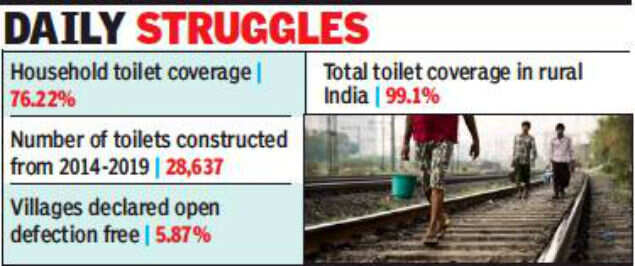
PANAJI: Despite the massive push by the Prime Minister Narendra Modi-led government to make all states open defecation free, Goa has managed to raise a stink, one the government can’t flush away. The state is not only one of the four in the country that has failed to achieve 100% household toilet coverage in rural areas, it also has the lowest number of individual household toilets in the country, according to the latest Swachh Bharat Mission-Gramin data.
The news gets worse. According to data released by the Union ministry of sanitation and drinking water, just 5.87% of Goa’s villages have been declared open defecation free (ODF), again the lowest coverage in the entire country.

Keeping Goa company are Odisha, Telangana and West Bengal, but even they have managed to distance themselves from Goa’s stink. Odisha has managed to declare 43.91% of its villages open defecation free, 63.2% of Telangana is ODF compliant, and West Bengal is 95.6% ODF compliant.
ODF is the termination of faecal-oral transmission, defined by no visible faeces found in the village and the use of safe methods by each household to treat the waste.
Goa’s tiny size a reason for worry, find policy makers
Former chief minister Manohar Parrikar had assured legislators during the monsoon session of the Goa legislative assembly in 2018 that the state government was working on “a war footing” to achieve ODF targets for both North and South Goa. He had added that the Goa government would install 60,000 bio-toilets at a cost of Rs 280 crore to make the state open defecation free.
In the four years since the Modi government announced plans to make India open defecation free by October 2019, Goa’s household toilet coverage has increased marginally from 60% in 2014-15 to 76.2% today. Since Modi announced the ambitious project on October 2, 2014, the number of toilets in Goa has increased by 16% to 28,637, but this is attributed to the organic growth of toilets.
Goa Waste Management Corporation (GWMC) had floated an RFP for the supply of 60,000 bio-toilets, and the bio-toilets were to be supplied within three months, said an official who is part of the tender process. However, the state government has struggled to get viable bids from companies for the project.
GWMC sources point out that it has yet to empanel contractors to supply and install the 700-litre capacity bio-digester household latrines.
“The process is on, the bids have been received, but because the code is in place, we cannot proceed. However, we will see that it is completed at the earliest,” said GWMC managing director Levinson Martins.
What has worried policymakers is Goa’s relatively tiny size compared to the other states — Odisha, Telangana and West Bengal — which makes the data even more baffling.
To put things in perspective, Goa has 375 villages compared to 51,352 villages in Odisha and 40,783 in West Bengal.
According to the 2011 census, Odisha had a population of around 4.2 crore, while West Bengal is estimated to have a population of 9.1 crore. Telangana has an estimated population of 3.5 crore, while Goa’s population is around 14.6 lakh.
District-wise, North Goa fares slightly better with 77.84% homes equipped with toilets, while the number for South Goa stands at 73.81%.
The news gets worse. According to data released by the Union ministry of sanitation and drinking water, just 5.87% of Goa’s villages have been declared open defecation free (ODF), again the lowest coverage in the entire country.

Keeping Goa company are Odisha, Telangana and West Bengal, but even they have managed to distance themselves from Goa’s stink. Odisha has managed to declare 43.91% of its villages open defecation free, 63.2% of Telangana is ODF compliant, and West Bengal is 95.6% ODF compliant.
ODF is the termination of faecal-oral transmission, defined by no visible faeces found in the village and the use of safe methods by each household to treat the waste.
Goa’s tiny size a reason for worry, find policy makers
Former chief minister Manohar Parrikar had assured legislators during the monsoon session of the Goa legislative assembly in 2018 that the state government was working on “a war footing” to achieve ODF targets for both North and South Goa. He had added that the Goa government would install 60,000 bio-toilets at a cost of Rs 280 crore to make the state open defecation free.
In the four years since the Modi government announced plans to make India open defecation free by October 2019, Goa’s household toilet coverage has increased marginally from 60% in 2014-15 to 76.2% today. Since Modi announced the ambitious project on October 2, 2014, the number of toilets in Goa has increased by 16% to 28,637, but this is attributed to the organic growth of toilets.
Goa Waste Management Corporation (GWMC) had floated an RFP for the supply of 60,000 bio-toilets, and the bio-toilets were to be supplied within three months, said an official who is part of the tender process. However, the state government has struggled to get viable bids from companies for the project.
GWMC sources point out that it has yet to empanel contractors to supply and install the 700-litre capacity bio-digester household latrines.
“The process is on, the bids have been received, but because the code is in place, we cannot proceed. However, we will see that it is completed at the earliest,” said GWMC managing director Levinson Martins.
What has worried policymakers is Goa’s relatively tiny size compared to the other states — Odisha, Telangana and West Bengal — which makes the data even more baffling.
To put things in perspective, Goa has 375 villages compared to 51,352 villages in Odisha and 40,783 in West Bengal.
According to the 2011 census, Odisha had a population of around 4.2 crore, while West Bengal is estimated to have a population of 9.1 crore. Telangana has an estimated population of 3.5 crore, while Goa’s population is around 14.6 lakh.
District-wise, North Goa fares slightly better with 77.84% homes equipped with toilets, while the number for South Goa stands at 73.81%.
Make sense of the 2019 Lok Sabha elections and results on May 23 with The Times of India. Follow TOI to track latest news, live updates, news analysis and cutting-edge data analytics. Track live election results, the big trends and fastest news updates from each of India's 543 Lok Sabha constituencies on the counting day with India's largest news network.
#ElectionsWithTimes
Quick Links
Lok Sabha Election Schedule 2019Lok Sabha Election NewsDelhi Capitals teamMI team 2019Rajasthan Royals 2019RCB team 2019Maharashtra Lok Sabha ConstituenciesBJP Candidate ListBJP List 2019 TamilnaduShiv Sena List 2019AP BJP List 2019Mamata BanerjeeBJP List 2019 MaharashtraPriyanka GandhiBJP List 2019 KarnatakaAMMK Candidate List 2019BJP List 2019 WBLok Sabha Elections in Tamil NaduBSP List 2019 UPNews in TamilLok Sabha Poll 2019Satta Matka 2018PM ModiMahagathbandhanNagpur BJP Candidate ListChandrababu NaiduTamil Nadu ElectionsUrmila MatondkarNews in TeluguMadras High CourtTejashwi YadavArvind KejriwalTejasvi SuryaPawan KalyanArvind KejriwalYogi AdityanathJaya PradaSatta King 2019Srinagar encounter
Get the app









